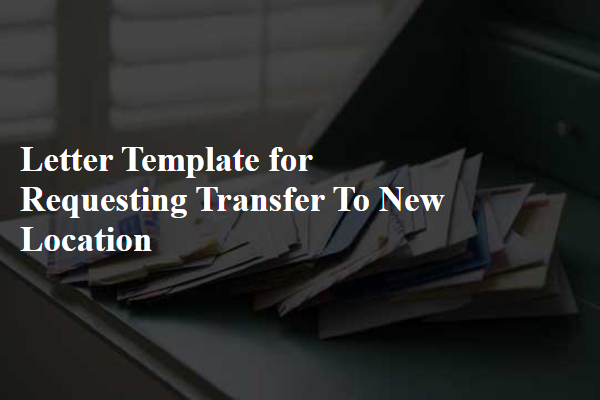Are you considering a move to a new location and need to formally request a transfer? Writing a letter for your transfer request doesn't have to be daunting. With a few thoughtful details and a clear structure, you can communicate your desire effectively while maintaining professionalism. Curious about how to craft the perfect transfer letter? Read on for a helpful template and tips!

Clear Subject Line
A request for a transfer to a new location often stems from personal, professional, or family-related reasons. The process typically involves submitting a formal application to a designated human resources representative or manager within the organization. Key details to include are the current role or position held, the specific new location being requested, and justifications such as career advancement opportunities, relocation of family members, or personal circumstances that necessitate the move. Including timelines for a potential transfer can also demonstrate foresight and planning, making the request more compelling. Additionally, mentioning any past contributions to the company and expressing a desire to continue fostering success at the new location can enhance the likelihood of approval.
Personal Details
Company policies often facilitate employee transfer requests based on personal circumstances. Individuals seeking relocation may submit requests driven by factors like family commitments, health considerations, or career advancement opportunities. A well-structured application typically includes essential personal details such as name, employee ID (for identification purposes), current position, and contact information. The transfer request should also specify the desired new location, specifying the city or office branch, which is crucial for the human resources department to assess and process the request accurately. It is advisable to outline reasons for the transfer and how it aligns with both personal and organizational goals, demonstrating commitment to the company while addressing individual needs.
Reason for Transfer
A transfer request often stems from personal circumstances or career development opportunities. Relocation could be triggered by family responsibilities requiring attention, such as the need to care for an elderly parent in another city or state. Professional aspirations play a crucial role in such requests, especially when a specific location, such as a major office in New York City or a tech hub in Silicon Valley, provides unique growth opportunities. Personal health considerations might also influence transfer requests, requiring a move to a region with better medical facilities. Furthermore, inquiries about remote work policies or organizational restructuring might lead employees to seek transfer opportunities that align more closely with their career goals or lifestyles.
Benefits to the Company
Requesting a transfer to a new location can significantly enhance employee productivity and morale, as demonstrated in organizations like Google and Amazon. A well-planned relocation to a hub such as Silicon Valley (the heart of tech innovation) enables employees to leverage local networking opportunities, fostering collaboration and creativity. Additionally, the move can reduce operational costs by transferring resources closer to key markets, which can streamline logistics and improve response times. Companies that prioritize employee satisfaction often witness lower turnover rates and higher engagement, ultimately leading to improved performance metrics. In 2023, statistics showed that companies investing in employee well-being reported a 30% increase in productivity, reinforcing the importance of strategic relocations.
Formal Request and Closing
A formal transfer request often involves specific details related to the current position, the prospective location, and the reasons for the transfer. For example, an employee may be wishing to relocate to a different city due to personal circumstances, such as family obligations or a desire for professional growth in a more dynamic market. Articulating the rationale is important, often mentioning the company's values, such as employee development and enhancing work-life balance. Additionally, the request should include a clear mention of the current designation, the desired position at the new location, and a note of appreciation for consideration by the management. Quantifiable accomplishments and contributions at the current location may also reinforce the applicant's qualifications for the new position.
Letter Template For Requesting Transfer To New Location Samples
Letter template of request for departmental transfer for career advancement













Comments